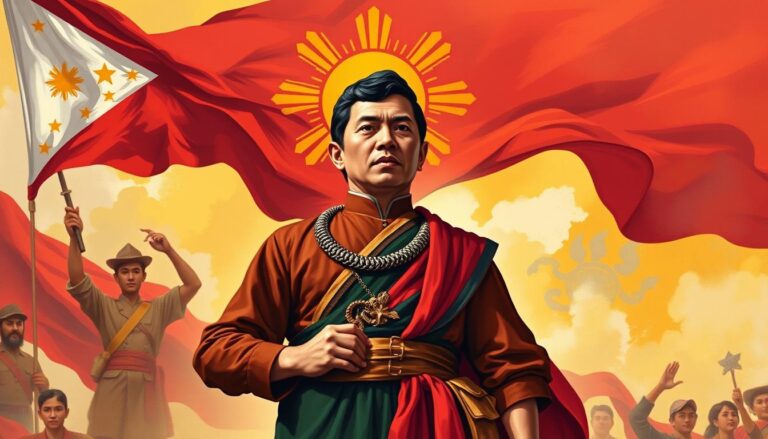The Philippine Constitution: Evolution and Impact
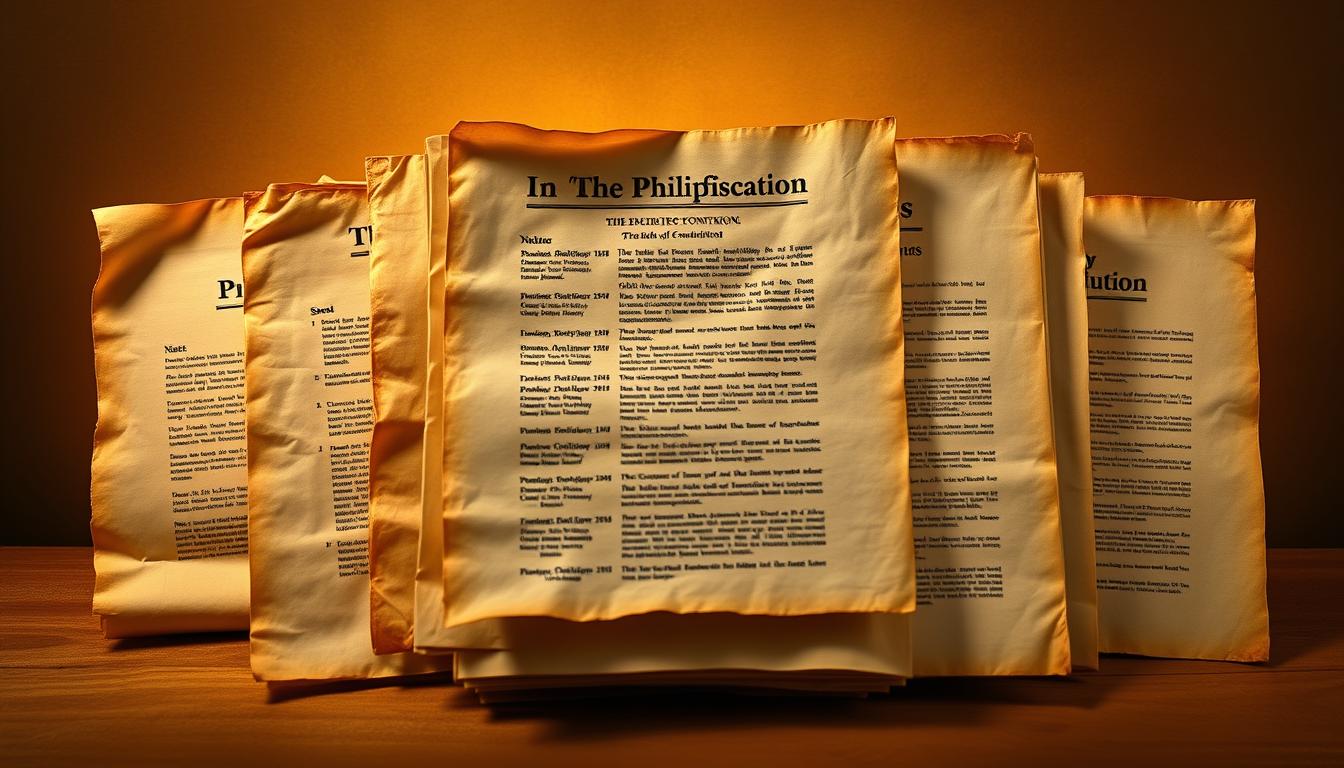
As the supreme law ratified in 1987, this framework reshaped governance after decades of political shifts. Born from the People Power Revolution, it replaced authoritarian structures with democratic safeguards. Historical roots trace back to the 1899 Malolos Charter, marking the nation’s first steps toward self-rule.
Drafted by a 48-member commission, the document restored presidential systems while ensuring checks on power. Three independent branches—executive, legislative, and judicial—anchor its design, preventing concentrated authority. Civil liberties like due process and environmental rights gained constitutional protection, reflecting evolving societal values.
Regional autonomy provisions addressed Mindanao’s unique needs, balancing unity with cultural diversity. A nationwide plebiscite saw overwhelming public approval, cementing its legitimacy. Over 35 years, courts have interpreted articles to resolve cases involving elections, land reform, and human rights.
Though unamended since ratification, debates persist about modernization. Key institutions like the Commission on Elections maintain accountability, while the Supreme Court upholds legal boundaries. This living document continues guiding policy amid globalization and technological change.
Historical Background of the Philippine Constitution
Legal frameworks in the islands evolved through three colonial eras before achieving full sovereignty. Spanish rule introduced European codes like the Fuero Juzgo, merging with local customs. This hybrid system lasted until 1898 when revolutionary leaders drafted Asia’s first republican charter.
American occupation brought new governance models after the 1898 Treaty of Paris. The 1935 Commonwealth Charter became pivotal, blending U.S.-style checks with local needs. Key features included:
| Document | Year | Key Features |
|---|---|---|
| Malolos Charter | 1899 | First popular sovereignty model |
| Commonwealth Charter | 1935 | Presidential system, Bill of Rights |
| Martial Law Constitution | 1973 | Parliamentary framework (unimplemented) |
| Current Framework | 1987 | Enhanced civil protections |
World War II disrupted legal development when Japan imposed its 1943 charter. Post-war reforms restored democratic processes, leading to full independence in 1946. The Supreme Court later overturned Marcos-era laws, reaffirming judicial independence.
Each constitutional shift reflected changing power dynamics. External influences and internal reform movements shaped provisions for elections, land rights, and citizen participation. These changes laid groundwork for modern governance structures.
Formation of the 1987 Constitution
Democratic revival in the mid-80s demanded urgent constitutional restructuring. After two decades of authoritarian rule, citizens mobilized through nonviolent protests to reclaim self-governance. This grassroots movement created the political space for systemic reforms.
People Power Revolution and Proclamation No. 3
Widespread electoral fraud in 1986 sparked nationwide demonstrations. Millions occupied Manila’s streets until Ferdinand Marcos’ regime collapsed. Newly installed President Corazon Aquino issued Proclamation No. 3, abolishing Marcos-era laws within weeks.
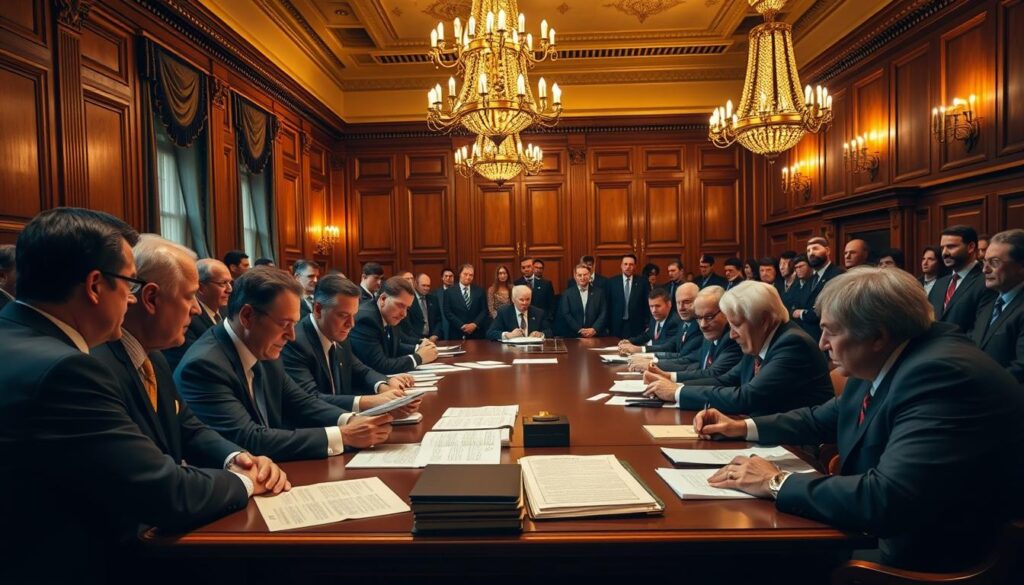
The provisional “Freedom Constitution” established transitional justice mechanisms. It dissolved parliament, banned former officials from office, and set deadlines for charter reforms. This legal reset enabled fresh elections and institutional audits.
Role of the Constitutional Commission
Aquino appointed 48 experts from diverse fields to draft the new framework. Lawyers, farmers, and business leaders collaborated through 18-hour sessions. Key debates centered on:
| Issue | Challenge | Resolution |
|---|---|---|
| Land Reform | Resistance from landowners | Mandated redistribution timelines |
| Foreign Investments | Economic sovereignty concerns | 60% local ownership rule |
| Military Oversight | Preventing coups | Civilian control provisions |
Public hearings gathered 3,000+ proposals from advocacy groups. Labor unions pushed for worker protections, while church leaders demanded social justice clauses. The commission finalized the text in 133 days—a record for comprehensive charters.
Voters ratified the document with 77% approval, restoring checks on executive power. This participatory process became a model for post-authoritarian states seeking legal renewal through citizen engagement.
Influences of Past Constitutions on Modern Governance
Modern governance structures mirror centuries of legal evolution blended with revolutionary ideals. Early frameworks like the 1899 Malolos Charter introduced parliamentary systems, while the 1935 document established presidential term limits. These concepts evolved into today’s hybrid model balancing centralized authority with local autonomy.
Three distinct patterns emerge when comparing foundational documents:
- Checks on power: The 1987 version expanded judicial review beyond the 1935 Charter’s scope
- Citizen protections: Social justice clauses strengthened rights first outlined in 1973
- Global integration: International law recognition surpassed earlier isolationist policies
Spanish colonial codes left lasting marks through civil law traditions. American influences appear in bill of rights provisions and separation of powers. Indigenous dispute resolution methods shaped barangay-level justice systems still used today.
Courts frequently reference pre-1987 cases when interpreting modern laws. A 1993 Supreme Court ruling cited 1935 precedents to uphold land reform timelines. This continuity ensures stability while allowing gradual change through legislative updates.
Lessons from past failures directly shaped current policy. Martial law-era abuses led to strict military oversight rules. Term limits prevent prolonged executive control, addressing flaws in earlier systems. As legal scholar Renato Cruz notes: “Each constitutional iteration builds immunity against previous governance viruses.”
Core Principles and Values of the Constitution
Rooted in democratic ideals, the 1987 framework prioritizes citizen sovereignty and human dignity. Its preamble declares the people as ultimate authority, embedding accountability into every layer of governance. This charter transformed legal systems by placing individual freedoms at the center of national policy.

Article III’s Bill of Rights safeguards essential liberties through 22 provisions. Key guarantees include:
| Right | Constitutional Basis | Impact |
|---|---|---|
| Due Process | Article III, Section 1 | Prevents arbitrary state actions |
| Free Speech | Article III, Section 4 | Enables public discourse |
| Equal Protection | Article III, Section 1 | Bans discrimination |
Justice and equality form the charter’s ethical backbone. Courts frequently cite Article II’s social justice mandate when reviewing land reform cases. A 2021 Supreme Court ruling halted evictions during lockdowns, invoking “the state’s duty to protect vulnerable sectors.”
Balancing state power remains crucial. While officials can enact public health measures, recent decisions struck down overly broad travel bans as rights violations. This equilibrium ensures neither branch dominates others.
Free expression protections faced tests during internet law debates. In 2018, justices voided parts of a cybercrime statute threatening online dissent. Such cases demonstrate how constitutional values adapt to modern challenges while preserving fundamental freedoms.
Key Provisions and the Bill of Rights
Legal safeguards in the 1987 framework empower citizens to challenge state overreach while balancing collective security needs. Article III’s 22-section Bill of Rights anchors this equilibrium, merging international human rights standards with local governance realities.
Ensuring Due Process and Equal Protection
Section 1 mandates both procedural and substantive fairness across all government actions. Courts require officials to justify arrests, property seizures, or penalties with clear legal bases. A 2020 ruling invalidated pandemic-related detention orders lacking proper documentation.
Equal protection clauses prevent discriminatory laws targeting specific groups. Landmark cases have struck down policies restricting access to education based on gender or economic status. Judges frequently cite Article II’s social justice mandate when reviewing welfare programs.
Freedom of Speech and Assembly
Section 4 shields dissent through robust free expression guarantees. Protests require no permits if conducted peacefully in designated areas. However, courts allow content-neutral restrictions during emergencies—like limiting rally sizes during health crises.
The 2018 Cybercrime Law case demonstrated these protections in digital spaces. Justices voided provisions criminalizing online libel, asserting that “new mediums demand expanded free speech interpretations.” This precedent now guides legislation on AI-generated content and data privacy.
Law enforcement must obtain warrants for surveillance under Section 3’s privacy rules. Evidence from illegal wiretaps gets excluded automatically, as seen in 2019 drug cases where charges collapsed due to procedural violations.
Separation of Powers: Executive, Legislative, and Judicial Branches
A delicate equilibrium defines governance under the 1987 framework, distributing authority across three co-equal branches. This system prevents concentration of control while enabling coordinated policy development. Each branch operates within strict boundaries defined by law, creating a self-correcting mechanism against overreach.
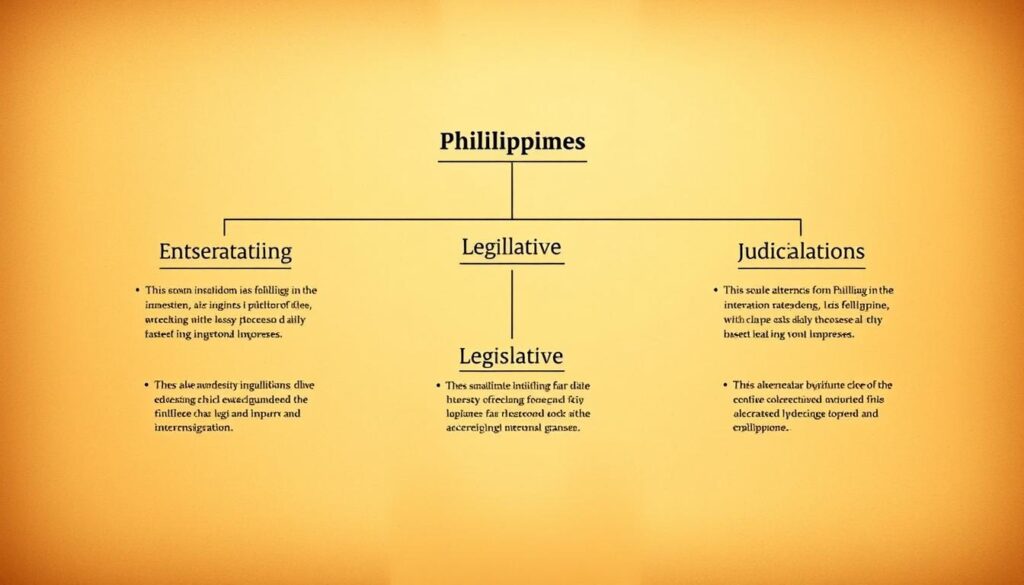
The executive branch, led by a single-term president, enforces laws and manages daily governance. Legislators craft policies through Congress’ bicameral system—24 senators and 300+ representatives. Courts interpret statutes, with Supreme Court justices serving until age 70 unless impeached.
Checks emerge through overlapping responsibilities. Presidents veto bills, but lawmakers override decisions with 2/3 votes. “No branch operates in isolation,” noted Chief Justice Maria Lourdes Sereno during the 2017 budget dispute. Conversely, courts invalidate executive orders violating constitutional rights, as seen in 2020 lockdown protocol rulings.
Historical precedents shaped these safeguards. The 1936 Angara case established judicial review principles later codified in Article VIII. Modern legislators reference 1973 charter flaws when debating military oversight reforms. Term limits for officials, introduced in 1987, directly address past authoritarian abuses.
Accountability flows through multiple channels:
- Congressional inquiries into executive decisions
- Judicial audits of government contracts
- Public impeachment processes for all branches
This structure ensures no entity becomes untouchable. Recent corruption cases against senators and mayors demonstrate its enforcement mechanisms. By maintaining distinct yet interdependent roles, the system adapts to crises without sacrificing democratic foundations.
Legislative Department: Structure and Functions
Lawmaking operates through a dual-chamber Congress designed to balance national priorities with local needs. This bicameral system ensures laws undergo rigorous scrutiny from multiple perspectives before enactment. Two distinct bodies—the Senate and House of Representatives—collaborate while maintaining independent oversight roles.
Senate and House of Representatives Explained
The 24-member Senate represents nationwide interests, with members elected through at-large voting. Qualifications include:
- Natural-born citizenship
- Minimum age of 35
- Six-year term limits
District representatives in the House mirror local constituencies, while party-list seats amplify marginalized voices. House members serve three-year terms, requiring residency in their districts for at least one year pre-election.
Checks and Balances in Lawmaking
Bills require approval from both chambers, creating natural friction against rushed decisions. “This process weeds out poorly crafted proposals,” observes legal analyst Manuel Reyes. Key mechanisms include:
- House-exclusive power to initiate revenue bills
- Senate authority to ratify treaties
- Conference committees reconciling differing versions
Impeachment powers demonstrate inter-branch accountability. The House files charges, while the Senate conducts trials—a structure tested during high-profile corruption cases.
Regular elections enforce accountability, with term limits preventing prolonged dominance. Recent reforms expanded party-list participation, ensuring 20% of House seats represent labor, urban poor, and indigenous groups. This framework adapts to shifting societal needs while maintaining constitutional stability.
Role of Constitutional Commissions and Independent Agencies
Guardians of democratic integrity operate through specialized bodies shielded from political pressures. The 1987 framework established three constitutional commissions, with COMELEC and the Civil Service Commission serving as critical checks on power. These agencies function independently from other branches, ensuring impartial oversight of elections and public sector operations.
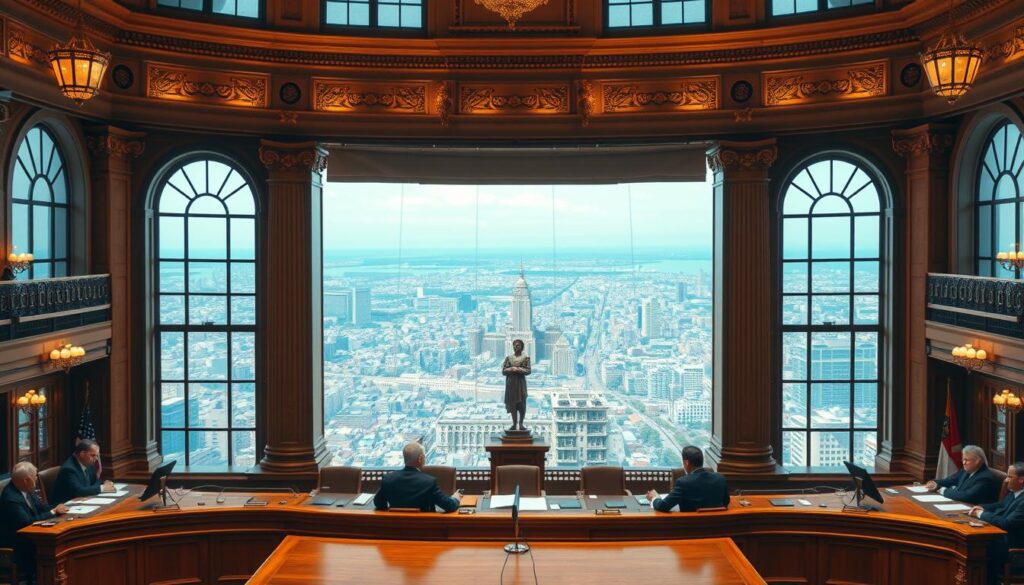
Commission on Elections
COMELEC enforces electoral laws with quasi-judicial authority. Its seven-member panel oversees voter registration, candidate qualifications, and campaign finance rules. During the 2016 national elections, the body disqualified 82 candidates for misdeclared assets—a move upheld by courts.
Key powers include:
- Deciding election protests within 12 months
- Prosecuting vote-buying cases
- Certifying automated voting systems
Civil Service Commission
This meritocracy watchdog administers over 1.4 million government positions. Through strict entrance exams and anti-corruption programs, it has removed 634 officials for graft since 2020. The CSC’s Code of Conduct bans nepotism and requires asset disclosure for all civil servants.
Both commissions enjoy fiscal autonomy under Article IX. Budget allocations automatically release without executive approval. Commissioners serve fixed seven-year terms, preventing sudden replacements during leadership changes.
“Independent agencies act as society’s immune system against governance abuses.”
Recent reforms expanded COMELEC’s digital oversight, enabling real-time monitoring of campaign expenses. Meanwhile, the CSC introduced blockchain technology for secure personnel records. These innovations strengthen accountability while adapting to modern challenges.
Citizenship and Suffrage: Defining Filipino Identity
Legal distinctions between citizenship types shape political participation in the archipelago’s democracy. Article IV of the 1987 framework clarifies who qualifies as a citizen, impacting voting rights and public service eligibility.
Natural-Born vs. Naturalized Citizens
Natural-born status applies to individuals with at least one Filipino parent at birth, regardless of birthplace. Foundlings like Senator Mary Grace Poe-Llamanzares gain this status through judicial confirmation. Naturalized citizens complete legal processes requiring residency and allegiance pledges.
| Criteria | Natural-Born | Naturalized |
|---|---|---|
| Birthright | Automatic | Acquired |
| Public Office Eligibility | All positions | Excludes presidency, Supreme Court |
| Process | None | Court petition or RA 9225 |
Suffrage under Article V requires only age (18+) and residency. No literacy tests or property rules exist—a shift from colonial-era restrictions. This inclusivity enables 67 million registered voters to shape policies.
Historical reforms expanded participation. Spanish codes limited voting to landowners, while American rulers introduced literacy tests. Post-1987 rules removed these barriers, strengthening national identity through collective decision-making.
Courts uphold these standards rigorously. The 2016 Poe case affirmed that citizenship disputes focus on legal proofs, not political motives. Such rulings maintain trust in electoral systems while protecting constitutional rights.
Judicial Integrity and Constitutional Oversight
Courts serve as society’s guardians against abuses of authority, balancing legal principles with public trust. The 1987 framework established a multi-layered judicial system anchored by the Supreme Court. This structure ensures laws align with constitutional values while protecting citizen rights.

Structure and Appointment Process
Fifteen justices—one Chief and fourteen Associates—form the nation’s highest court. Presidents select nominees from candidates vetted by the Judicial and Bar Council. Requirements include:
- Natural-born citizenship
- Minimum age of 40
- 15+ years as judge or practicing lawyer
Lower courts handle regional and specialized cases, while the Supreme Court reviews constitutional disputes. Its powers span three critical areas:
| Jurisdiction Type | Scope | Example Cases |
|---|---|---|
| Original | Ambassador disputes | Diplomatic immunity claims |
| Appellate | Law constitutionality | Tax reform challenges |
| Administrative | Court supervision | Judicial misconduct rulings |
Landmark decisions showcase this authority. In 2012, justices voided parts of an anti-terror law threatening free speech. A 2020 ruling mandated environmental impact studies for mining permits, citing Article II’s ecological protections.
Checks on judicial power prevent overreach. Congress can impeach justices for misconduct, while the executive appoints replacements. “Courts interpret laws but don’t write them,” emphasized retired Chief Justice Hilario Davide during a 2018 constitutional forum.
Pathways to Amendments and Constitutional Reforms
Changing the nation’s foundational law requires navigating complex legal channels designed to balance stability with adaptability. Three methods exist for proposing revisions, each presenting unique procedural hurdles and political considerations.
Legal Mechanisms for Change
Article XVII outlines these pathways:
| Method | Process | Success Rate |
|---|---|---|
| Constituent Assembly | Congress members propose changes | 0% since 1987 |
| Constitutional Convention | Delegates elected for revisions | Last used 1971 |
| People’s Initiative | Public petition drives | Blocked by courts |
The Supreme Court invalidated two People’s Initiative attempts in 1997 and 2006, calling signature requirements “legally insufficient.” This leaves legislative routes as primary options.
Political Roadblocks
Recent reform efforts faced public skepticism. A 2018 Pulse Asia survey showed 67% opposition to charter changes, fearing political agendas. The 2016 “Bayanihan Constitution” proposal under President Duterte collapsed after lawmakers disputed federalism clauses.
Key challenges include:
- Super majority requirements in Congress
- Public distrust of political motives
- Judicial interventions on procedural flaws
Successful amendments could reshape economic policies and term limits. However, as constitutional scholar Raul Pangalangan notes: “Reform requires rare alignment of public consensus and political will.”
The Philippine Constitution and Democracy
Democracy thrives when foundational laws empower citizens to shape their governance. The 1987 framework transformed politics by embedding participatory mechanisms directly into legal systems. Public protests like the People Power Revolution demonstrated how collective action could reset power structures—a principle now protected through free assembly rights.
- Accountability measures: Article XI subjects officials to impeachment for abuses
- Inclusive policymaking: Mandatory public hearings precede major legislation
- Judicial guardianship: Courts void laws violating electoral fairness
Recent cases showcase these principles. In 2022, the Supreme Court blocked attempts to extend term limits, citing Article VII’s anti-dynasty spirit. Another ruling required real-time disclosure of campaign funds, strengthening electoral transparency. Such decisions reinforce trust in institutions.
Balancing majority rule with minority protections remains crucial. While 89% of citizens approve democratic processes (2022 survey), Article XIII ensures marginalized groups access essential services. Indigenous communities now veto mining projects affecting ancestral lands—a right upheld in 2021 court cases.
“Constitutional democracy adapts through citizen engagement, not rigid mandates.”
Open governance initiatives like digital budget tracking let voters monitor spending. These tools operationalize Article II’s welfare mandate, proving foundational laws evolve alongside societal needs. Civic participation thus becomes both right and responsibility under this living framework.
Impact on National Development and Policy Making
Economic growth and policy effectiveness hinge on legal frameworks guiding governance decisions. Since 1987, foundational laws have shaped strategies addressing poverty reduction and regional disparities. Article II’s social justice mandate directly influenced land reform programs, redistributing 4.8 million hectares to farmers by 2022.
Key policy outcomes emerged from constitutional principles:
| Indicator | Pre-1987 | Post-1987 |
|---|---|---|
| GDP Growth (Annual) | 1.38% | 5.6% avg (2000-2023) |
| Poverty Rate | 33% (1985) | 16.4% (2023) |
| Policy Framework | Centralized | Decentralized |
Labor protections under Article IX increased minimum wages by 142% since ratification. However, challenges persist—uneven resource distribution still affects 58% of rural municipalities. Courts have resolved 19 landmark cases since 2010 involving environmental policies and infrastructure projects.
“Legal frameworks determine whether nations thrive or stagnate. The 1987 reforms created Asia’s 12th-fastest growing economy.”
Three systemic shifts drove progress:
- Accountable institutions: Anti-corruption measures recovered $2.9B in misused funds
- Citizen participation: Public consultations required for major bills
- Judicial oversight: 73% of contested policies underwent constitutional review
While digital governance tools improved transparency, 42% of citizens report limited access to legal services. Balancing economic priorities with rights protections remains critical for sustainable progress.
Challenges in Implementing Constitutional Provisions
Enforcing constitutional directives encounters multifaceted obstacles in practice. Despite strong legal safeguards, systemic issues often weaken accountability and public trust. A 2023 survey revealed 75% of citizens lack basic knowledge of their rights under the framework, complicating enforcement efforts.
Corruption and Political Barriers
Powerful networks frequently exploit gaps in oversight. The 2023 People’s Initiative scandal exposed how officials manipulated amendment processes through vote-buying tactics. Critics argue such actions undermine the 1986 commission’s original intent to prioritize citizen welfare.
Key issues include:
- Delayed prosecution of graft cases (average 6.2 years per trial)
- Resource mismanagement in local governments
- Lobby groups influencing judicial appointments
Ensuring Effective Law Enforcement
Courts face backlogs exceeding 900,000 cases nationwide. While Article III guarantees speedy trials, understaffed offices struggle with outdated systems. A 2022 audit found 43% of police stations lacked equipment to process digital evidence.
| Challenge | Impact | Proposed Reform |
|---|---|---|
| Weak whistleblower protections | Discourages corruption reporting | Expand witness security programs |
| Politicized appointments | Undermines judicial independence | Merit-based selection panels |
| Limited public awareness | Reduces civic oversight | Mandatory rights education in schools |
Recent reforms show promise. Blockchain technology now tracks legislative budgets, improving transparency. However, 88% of citizens oppose further amendments, fearing renewed power grabs. Experts urge leveraging existing laws before pursuing risky changes.
Contemporary Relevance in Modern Governance
Foundational legal principles continue steering governance through 21st-century challenges. Three decades after ratification, the 1987 framework remains central to resolving debates on digital privacy and regional autonomy. Recent elections tested its safeguards against misinformation campaigns, with courts annulling fraudulent candidacies under Article IX.
Judicial interpretations adapt rights protections to new realities. In 2023, the Supreme Court ruled facial recognition systems require warrants, citing Section 2’s privacy guarantees. Lawmakers now debate AI regulation using Article III’s free speech parameters as guidance.
Key areas show the system’s adaptability:
| Challenge | Constitutional Response | Outcome |
|---|---|---|
| Mindanao peace process | Article X autonomy provisions | Bangsamoro region established (2019) |
| Pandemic response | General welfare clause (Article II) | Vaccine mandates upheld (2021) |
| Digital rights | Free expression protections | Cyberlibel decriminalized (2022) |
Civil society groups leverage Article XIII to challenge mining permits threatening indigenous lands. A 2023 case halted a nickel project in Palawan, demonstrating environmental rights enforcement. However, delayed justice remains problematic—62% of human rights cases take 5+ years to resolve.
Ongoing reforms address emerging needs. Blockchain technology now tracks legislative budgets, while revised voter ID systems combat election fraud. As activist Maria Ressa observes: “Constitutional rights only matter if citizens can enforce them daily.”
Conclusion
Over three decades since ratification, the 1987 framework remains democracy’s anchor through shifting political tides. Its creation marked a turning point—replacing authoritarian rule with checks on power while enshrining civil liberties. Historical roots from colonial charters to revolutionary ideals merged into a system balancing governance with citizen sovereignty.
Core principles like judicial independence and electoral accountability continue shaping national progress. Courts have upheld land reform timelines, digital privacy rights, and environmental protections using this living document. Recent rulings on AI regulation and pandemic policies prove its adaptability to modern challenges.
Persistent issues demand attention. Corruption risks and delayed justice reforms test institutional resilience. Public engagement remains vital—as seen in successful advocacy for indigenous land rights and transparent elections. Future amendments must prioritize inclusivity while preserving hard-won freedoms.
This legal blueprint unites diverse communities under shared democratic values. From local governance to Supreme Court benches, its influence permeates every layer of society. As technology and globalization evolve, the framework’s emphasis on human dignity ensures laws serve people—not power.





